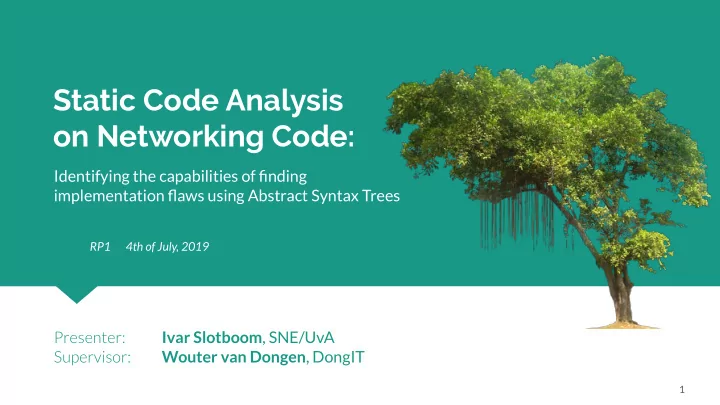

RP1 Presenter: Ivar Slotboom Supervisor: Wouter van Dongen , DongIT UvA/SNE Static Code Analysis on Networking Code: Identifying the capabilities of finding implementation flaws using Abstract Syntax Trees RP1 4th of July, 2019 Presenter: Ivar Slotboom , SNE/UvA Supervisor: Wouter van Dongen , DongIT 1
RP1 Presenter: Ivar Slotboom Supervisor: Wouter van Dongen , DongIT UvA/SNE Static code analysis Find bugs and performance issues. ● Produce a report providing feedback and improvement points. ● Often powered by machine learning. ● 2
RP1 Presenter: Ivar Slotboom Supervisor: Wouter van Dongen , DongIT UvA/SNE Abstract syntax trees (AST) Break down static code into nodes. ● AST output is a structure on how the code is read by the ● interpreter. Nodes tree where you can traverse through its child and parent ● nodes. 3
RP1 Presenter: Ivar Slotboom Supervisor: Wouter van Dongen , DongIT UvA/SNE 4
Research question Is it possible to create a tool to analyze static Python code to detect potential network implementation flaws? How can network implementation flaws be detected using Abstract Syntax Trees? What are the limitations of identifying network implementation issues using Abstract Syntax Trees?
RP1 Presenter: Ivar Slotboom Supervisor: Wouter van Dongen , DongIT UvA/SNE Related work Tasnim and Rahman - ASTs do not describe every detail of the syntax, but enough to identify patterns and Al Bessey et al. flaws. - Static Code Analysis done preferably: Goseva-Popstojanova et al. - Minimal manual setup. - Maximum serious issues. - Researched the capabilities of static code - Minimum false positives. analysis. - Making an analyzer is an iterative process. - Not very effective in detecting security - Best reports come when all context is vulnerabilities. available. - Sees opportunity to be more effective than - No code equals to no error. manual inspection. 6
RP1 Presenter: Ivar Slotboom Supervisor: Wouter van Dongen , DongIT UvA/SNE Methodology Iterative process to create an analyzer, as well as test projects to test the analyzer on. Analyzer: Uses AST to parse the test project in ● question. Uses predefined rulesets to spot ● implementation flaws. Test projects: Purposefully implement network flaws. ● Simulate real-world scenarios. ● All code publically available on GitHub. 7
Results 8
RP1 Presenter: Ivar Slotboom Supervisor: Wouter van Dongen , DongIT UvA/SNE AST parsing is an effective method Network implementation flaws are usually implemented on a higher level. This makes it easier to discover for the analyzer. It is important that the rules are well ● defined. It is possible to traverse the node tree ● backwards to find out what happened. 9
RP1 Presenter: Ivar Slotboom Supervisor: Wouter van Dongen , DongIT UvA/SNE Multi-file projects AST parsing does not mind merging two files into one. The analytical results stay the same. + 10
RP1 Presenter: Ivar Slotboom Supervisor: Wouter van Dongen , DongIT UvA/SNE Limitation 1: Threading Causes unique, unpredictable ● behaviour. Can only be checked on run time. ● May alter context that is required for ● analysis. Some rules cannot be checked ● because of run time requirements, e.g. socket dtors. 11
RP1 Presenter: Ivar Slotboom Supervisor: Wouter van Dongen , DongIT UvA/SNE Limitation 2: Imports Imports can be confused due to the nature of the Python language. How can we separate installed libraries from files? 1 Use heuristics, check if file exists in the directory. 2 Parse installed libraries to match alias. Either way, context is lost. 12
RP1 Presenter: Ivar Slotboom Supervisor: Wouter van Dongen , DongIT UvA/SNE Limitation 3: Implementing rule definitions Every rule needs to traverse the node tree. ● Larger code bases have millions of lines of code. ● Alias names can be changed when used as arguments in functions. ● Overall: Very costly per rule definitions. May not scale well with larger codebases. 13
RP1 Presenter: Ivar Slotboom Supervisor: Wouter van Dongen , DongIT UvA/SNE Limitation 4: Dead code is still parsed “No code = no error”, but dead code could also lead to false reports. ● Could alter context wrongly as code may not always be called. ● Functions can be called based on runtime scenarios. ● 14
RP1 Presenter: Ivar Slotboom Supervisor: Wouter van Dongen , DongIT UvA/SNE 15
Conclusion It is possible to detect network implementation flaws using an AST , but limitations make it difficult to make it scalable and confident.
RP1 Presenter: Ivar Slotboom Supervisor: Wouter van Dongen , DongIT UvA/SNE How can network implementation flaws be detected using ASTs? Network implementation issues commonly are implemented on a high level. ● Node traversal can give context on the implementation in question. ● ASTs are not hindered by moved code. ● Iterative process as solutions to one bug could allow others to be found. ● 17
RP1 Presenter: Ivar Slotboom Supervisor: Wouter van Dongen , DongIT UvA/SNE What are the limitations of using ASTs to identify network implementation flaws? Static code versus run time code could hinder context during analysis. ● Imports are difficult to identify, which also affects the context of the analysis. ● Rule definitions are difficult to implement. ● Dead code could be altering context, or is hard to analyze itself. ● 18
RP1 Presenter: Ivar Slotboom Supervisor: Wouter van Dongen , DongIT UvA/SNE Future work Machine learning? Solution to dead code? Lower level languages? Commonly used in static How can you identify dead Require more detail to ● ● ● code analysis for bugs code in runtime function, e.g. C/C++. and performance issues. environments? Usually have projects with ● Could potentially find Is it possible to simulate larger code bases. ● ● patterns and behaviour runtime environments Could improve context from ● in network when analyzing static the output of AST, causing implementation flaws. code? less confusion such as imports. 19
Thank you for your time. Questions? 20
Recommend
More recommend